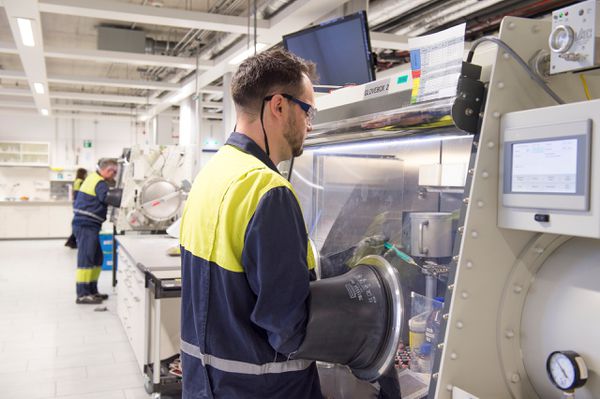
Sportswear brand ON designs running shoe made from carbon … – The Globe and Mail
Sportswear brand ON designs running shoe made from carbon … The Globe and Mail

Swiss sportswear brand ON announced the upcoming release of the Cloudprime, a running shoe whose sole uses foam made from the raw materials of carbon emissions.© ON/Handout
Runners in Canada may soon hit the road in shoes without a footprint.
ON, a decade-old Swiss sportswear brand that sponsors some of the world’s top distance runners, recently announced the upcoming release of the Cloudprime, a running shoe whose sole boasts foam made from the raw materials of carbon emissions. And despite its sustainable status, the company says it will keep pace with the newest high-performance shoes that have led to markedly faster finish times over the last five years.
Ilmarin Heitz, head of sustainability at ON, says the Cloudprime was conceived because the company threw out the assumption that a fully green product could never be top of the line: “We are starting to see that performance and sustainability don’t have to be an ‘or.’ They can be an ‘and’.”
The Cloudprime, which currently exists only as a prototype, will be comparable in weight, responsiveness and feel to the company’s flagship training shoe, the Cloudflow. But its production process, which relies on environmentally-friendly practices like fermentation, could not be more different.
First, carbon recycling technology captures greenhouse gases from industrial sources like steel mills before they are released into the atmosphere. The gases are then funneled into a reactor and fermented into liquid ethanol – a process similar to brewing beer. The ethanol is then dehydrated into ethylene gas and polymerized into lightweight plastic pellets made of ethylene vinyl acetate. These are then fused together to make the foam sole.
As of now, only the shoe’s foam is made of carbon emissions, but Mr. Heitz said ON plans to create future versions of the Cloudprime where the mesh on the top of the shoe, and its laces, would also be made from recycled plastic waste. The project is the company’s latest lunge towards its goal of running a fully-circular business – that is, one with a supply chain that uses only recycled and recovered resources – by 2030. Last year the company released the CloudNeo, a 100 per cent recyclable running shoe that, while not as fast as the Cloudprime, is made of bio-based material derived from caster beans.
But if ON has figured out how to create a carbon-negative shoe, they have yet to solve the puzzle of how to scale its production, and even less how to sell it for a profit. The Cloudprime prototype still has no target release date or price point. The company has already invested millions in research and performance tests, and estimates that producing one prototype currently costs several hundreds of thousands of dollars.
What drives that cost is a lack of a streamlined supply chain: there is no existing blueprint for mass-producing foam from carbon emissions, so Mr. Heitz and his team had to cobble one together. Right now, ON relies on a consortium of partnerships to facilitate each step of production – outsourcing the carbon capturing, the fermentation process and the ethylene gas polymerization to other companies.
“The cost of being first is that we cannot afford to do it alone; we are shaking up an industry and need partners to put in resources for us to succeed,” said Mr. Heitz, adding that he is convinced that, once more players invest in the space, the manufacturing costs of carbon-negative shoes will eventually be comparable to the cost of making foam from petroleum.
ON is not alone in making early steps towards sustainable running shoe production. In 2021, Reebok released the Floatride Energy Grow, which is made from 50 per cent plant-based materials and castor-bean based cushioning. And Brooks made the last two editions of its highest-selling training shoe, the Ghost, carbon-neutral by using recycled polyester and nylon to make much of its upper half.

© ON/Handout
Despite those advances, the running shoe industry, valued at $10-billion, is probably years away from a green revolution. In 2016, Nike’s creation of the Vaporfly – a shoe with a carbon-plated sole that has improved runners’ finishing times by as much as five per cent – has set sneaker brands on an innovation race too fast for sustainability-based technology to keep up.
For this reason, running journalist Brian Metzler – author of Kicksology: The Hype, Science, Culture & Cool of Running Shoes – still sees performance and sustainability to largely be mutually exclusive, at least in the near future.
“The challenge with making high performance shoes sustainable,” said Mr. Metzler, “is we have these carbon plates and propulsive foams now with amazing energy return getting better by the year, and we just don’t have the same types of results in a green product yet.”
As long as a disparity in results exists, said Mr. Metzler, competitive runners will opt for speed. But he expects that even the fastest shoes in the world will eventually be made of greener materials, as scientists discover how to make green shoes without sacrificing performance. For now, Saucony already makes part of the Endorphin Speed, one of its fastest training shoes, with recycled materials.
Mr. Heitz agrees that the world is still years away from seeing Olympians wearing recyclable shoes, but he says the momentum behind sustainable innovation is building exponentially.
“The leadership team thought we were crazy when we came out with this concept two years ago because nobody was doing it,” he said. “And now it’s like, ‘Of course this is the next step’.”